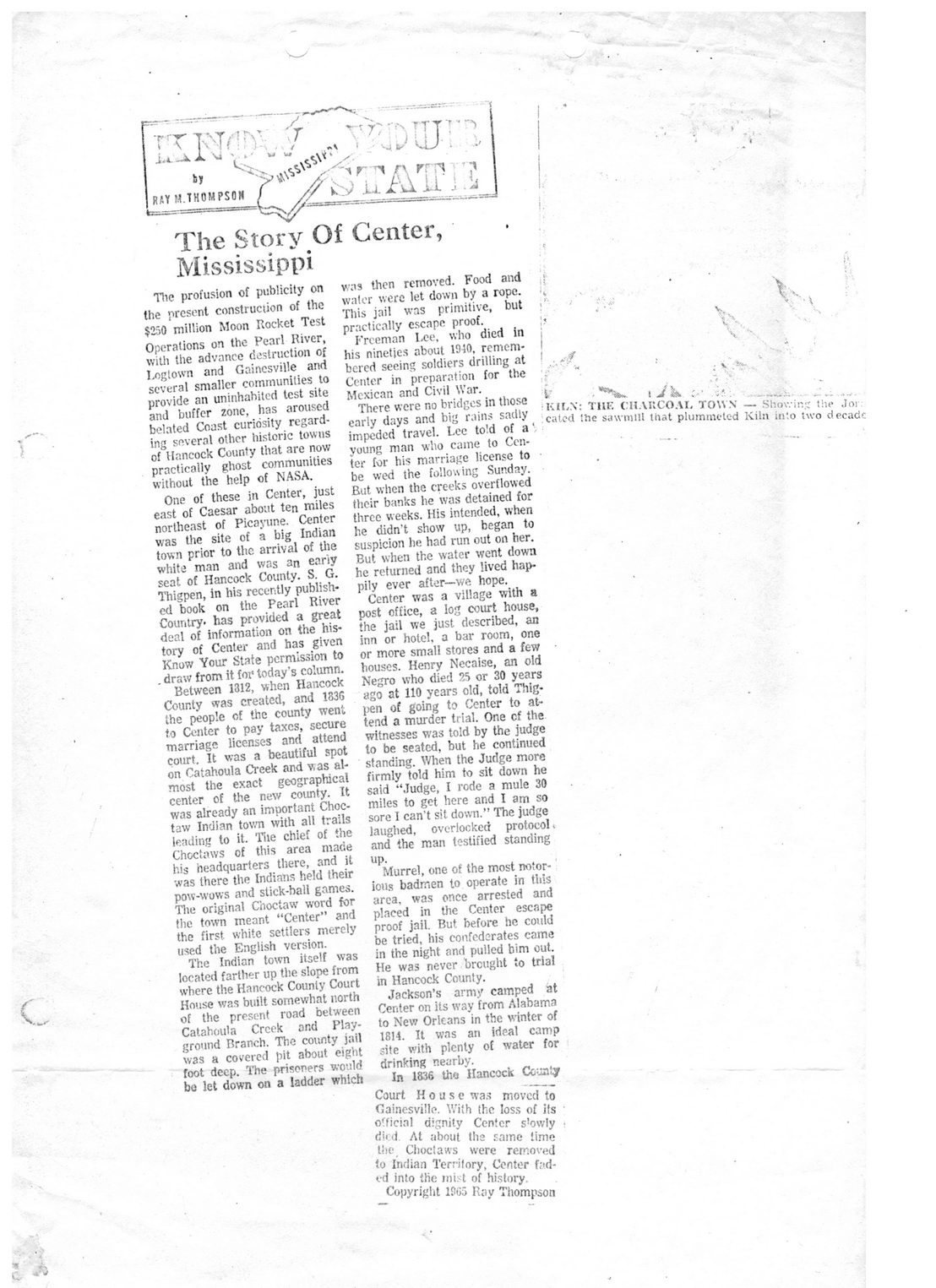This text was obtained via automated optical character recognition.
It has not been edited and may therefore contain several errors.
The Story Of Center, Mississippi The profusion of publicity on the present construction of the $250 million Moon Rocket Test Operations on the Pearl River, with the advance destruction of I-ogtown and Gainesville and several smaller communities to provide an uninhabited test site and buffer zone, has aroused belated Coast curiosity regarding several other historic towns of Hancock County that are now practically ghost communities without the help of NASA. One of these in Center, just east of Caesar about ten miles northeast of Picayune. Center was the site of a big Indian town prior to the arrival of the white man and was an eariy seat of Hancock County. S. G. Thigpen, in his recently published book on the Pearl River Country- has provided a great deal of information on the history of Center and has given Know Your State permission to . draw from it for today’s column. Between 1312, when Hancock County was created, and 1836 the people of the county went to Center to pay taxes, secure marriage licenses and attend court. It was a beautiful spot on Catahoula Creek and was almost the exact geographical center of the new county. It was already an important Choctaw Indian town with all trails leading to it. The chief of the Choctaws of this area made his headquarters there, and it was there the Indians held their pow-wows and stick-ball games. The original Choctaw word for the town meant “Center" and the first white settlers merely used the English version. The Indian town itself was located farther up the slope from where the Hancock County Court House was built somewhat north of the present road between Catahoula Creek and Playground Branch. The county jail was a covered pit about eight foot deep. The prisoners would bo let down on a ladder which was then removed. Food and water were let down by a rope. This jail was primitive, but practically escape proof. Freeman Lee, who died in his nineties about 1940, remembered seeing soldiers drilling at Center in preparation for the Mexican and Civil War. There were no bridges in those early days and big rains sadly impeded travel. Lee told of a ‘ young man who came to Center for his marriage license to be wed the following Sunday. But when the creeks overflowed their banks he was detained for three weeks. His intended, when he didn't show up, began to suspicion he had run out on her. But when the water went down he returned and they lived happily ever after—we hope. Center was a village with a post office, a log court house, the jail we just described, an inn or hotel, a bar room, one or more small stores and a few houses. Henry Necaise, an old Negro who died 25 or 30 years ago at 110 years old, told Thigpen of going to Center to attend a murder trial. One cf the witnesses was told by the judge to be seated, but he continued standing. When the Judge more firmly told him to sit down he said “Judge, I rode a mule 30 miles to get here and I am so sore I can’t sit down.” The judge laughed, overlooked protocol i and the man testified standing up. Murrel, one of the most notorious badmen to operate in this area, was once arrested and placed in the Center escape proof jail. But before he could be tried, his confederates came in the night and pulled bim out. He was never brought to trial in Hancock County. Jackson’s army camped at Center on its way from Alabama to New Orleans in the winter of 1814. It was an ideal camp site with plenty of water for drinking nearby. In 1836 tho Hancock County Court H o u s e was movedlo Gainesville. With (he loss of its X? a t°inity Ccnfer s’owly • ,, ‘ 1 ‘lbout ,!’2 same lime t‘i( Choctaws were removed to Indian Territory, Center hd-fd mto the mist of history Copyright 1965 Roy Thompson

Center Town Center-Ms-Ray-Thompson